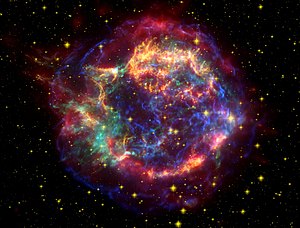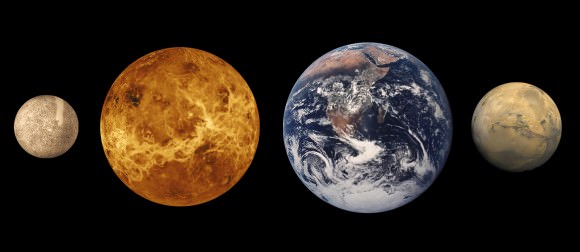Formation of the Solar System
Here is the concept divided into a few small
chunks to help you understand it:
- Nebular Hypothesis [Developed by scientists Imanuel Swedenborg, Pierre Simon-Laplace and Immanuel Kant]
 |
| The flat disk of the solar system arose from a diffuse cloud of gas and dust Credit: Universe Today |
The Solar System is believed to have formed 4.568 billion years ago from a giant molecular cloud spinning quite slowly, similar to the Orion Nebula, which was approximately 65 light years in diameter. Note that now, the Solar System is only about a little more than 1 light year. It was initially very cold, hundreds of degrees below 0 Fahrenheit. It was mostly composed of Hydrogen and Helium - the two lightest elements in the universe. Thus, the cloud was not very dense, but had a huge amount of mass - spread over 65 light years.
 |
| Cassiopeia A, what is called a supernova remnant Image credit: wikipedia.org |
The solar system, as we know it, formed when the shock waves of a nearby supernova of the star Cassiopeia A hit the molecular cloud and compressed some of its denser regions, thus causing them to collapse because of their internal gravity. The shockwaves amplified the spin of the cloud and thanks to angular momentum, as the density of the cloud increased, it shrank, and it began to spin faster and faster. [Similar to an ice skater who draws their arms inward to spin faster and faster.]
.jpg) |
| The early solar system with our protostar: the Sun Credit: Syfy |
Thus, the cloud was flattened into a thin disc. When the matter within the cloud was compressed, the kinetic energy of the subatomic particles
was converted into heat. Thus, the temperature of the cloud soared, especially
at the center of the disc, where most of the matter was accumulated. As the
cloud became hotter and hotter, nucleosynthesis began.
At some point the temperature at the center of the disc hit 10 million Kelvin. [Really 10 million℃, but, in the absolute scale.] Now, the temperature had reached just the right limit for thermonuclear fusion [or just simply nuclear fusion] to begin. In this process, the hydrogen atoms move fast enough to collide into one another and form Helium, the next heavier element. It was now that the center of the disc became a protostar. So, now the protostar or protosun, reached an equilibrium, when it could not be collapsed further by its own internal gravity, as it was exactly balanced by the heat produced through thermonuclear fusion. Our sun now entered the Main Sequence. Currently, the sun covers about 99.8 percent of the entire mass of the solar system.
At some point the temperature at the center of the disc hit 10 million Kelvin. [Really 10 million℃, but, in the absolute scale.] Now, the temperature had reached just the right limit for thermonuclear fusion [or just simply nuclear fusion] to begin. In this process, the hydrogen atoms move fast enough to collide into one another and form Helium, the next heavier element. It was now that the center of the disc became a protostar. So, now the protostar or protosun, reached an equilibrium, when it could not be collapsed further by its own internal gravity, as it was exactly balanced by the heat produced through thermonuclear fusion. Our sun now entered the Main Sequence. Currently, the sun covers about 99.8 percent of the entire mass of the solar system.
- Formation of the planets
The planets formed from the protoplanetary disc and matter left out from the sun’s formation.
While cohesion refers to the same particles of matter sticking together, to form larger “chunks”, self-organization refers to order arising in a disordered system. This is a part of chaos theory, which suggests that order arises in order to combat entropy.
 |
| Polar bond between water molecules due to cohesion. Image credit: usgs.gov |
Thus, in the solar system, particles came together to form 200 m clumps whichnow attracted bigger clumps due to their mutual gravity, forming planetesimals, and eventually, planets, like the Earth.
Here is the difference between the formation of the inner planets, the outer planets, the asteroids, Kuiper belt, and the Oort cloud:-
1. Inner solar system- The inner solar system includes the inner planets- Mercury, Venus, Earth and Mars as well as the asteroid belt. All of these celestial bodies have a dense rocky core, and are composed mainly of heavier elements, like iron, nickel, cobalt, silicon, oxygen, nitrogen, carbon, etc. They are also much smaller than the outer planets - the gas giants.
 |
| The inner planets Image credit: universetoday.com |
This is because of two
reasons -
- Firstly, regions close to the center of the disc were much hotter, thus causing nucleosynthesis to begin, leading to the creation of much heavier elements.
- Secondly, most of the material closer to the center of the disc was already used up by the sun. So, there simply wasn’t much material for the planets anymore, thus making them much smaller than their bigger outer gas giant counterparts.
- Another reason for the above was that the solar wind had blown away most of the material of the inner planets.
 |
| Solar Wind [The deep red circle is covering the sun. This is the view projected by a telescope] Image credit: NASA |
2. Outer Solar System- The outer Solar System consists of the outer planets, Jupiter, Saturn, Uranus and Neptune, as well as the Kuiper belt and the Oort cloud. In the outer solar system, there was a lot of matter, as it was quite far away from the sun. There were hardly any heavier elements as the region was quite cold. Thus, the planets were able to acquire more mass. Note that this is also the reason why the outer planets are referred to as ‘’Failed Cores’’ as they could not acquire enough heavier elements to build their cores when they formed.
 |
| Jupiter Image credit: wikipedia.org |
This entry was quite long and perhaps a little confusing, as a lot of new technical words and a lot of information was introduced. But, don’t worry, it might seem a little overwhelming right now, but believe me, you’ll soon get it!
The glossary down below might help you understand some technical words:-
[1] Orion Nebula- the Orion Nebula is a massive cloud of gas and dust, situated in the Milky Way Galaxy, to the south of the Orion Belt in the Orion Constellation.
[2] Light year- A light year is a unit of distance. It is the distance that light travels in one year. It is 9.4607*10^12 km.
[3] Supernova- A dramatic event in which a star blows itself apart, due to its gravitational collapse, at the end of its life cycle.
[4] Cassiopeia A- It is a supernova remnant in the Milky Way Galaxy in the Constellation Cassiopeia.
[5] Angular Momentum- Angular Momentum is the momentum of spin. It is written as L=mvr, where m is mass, v is the tangential velocity and r is the radius of the rotating body. According to the law of conservation of angular momentum, when no torque is applied, and the radius of a rotating object decreases, its velocity increases.
[6] Kinetic Energy- it is the energy that an object possesses due to its motion. It can also be thought of as the energy in a moving system.
[7] Nucleosynthesis-it is the process in which lighter elements got converted into heavier ones [forming iron, chromium, silicon, oxygen, carbon etc.], as the neutrons gobble up electrons.
[8] Main Sequence- Scientists use this term to describe a relatively happy and stable part of a star’s life, in which it fuses hydrogen into helium. [You can also look up an HR Diagram]
[9] Protoplanetary- In case you were wondering, the word ‘proto’ means primitive or early. Thus, a protoplanetary disc was actually the early plane of the planets in the solar system.
[10] Entropy-Disorder and randomness
[11] Kuiper belt- The circumstellar belt beyond the orbit of Neptune.
[12]Oort Cloud- it is a halo of icy planets and comets, enveloping the solar system.
[13] Solar Wind- it is a stream of charged particles, blowing outward from the sun.


Comments
Post a Comment